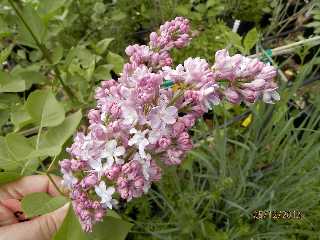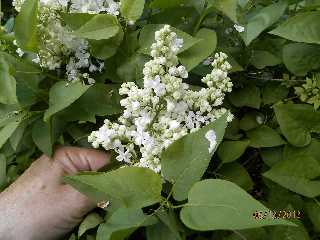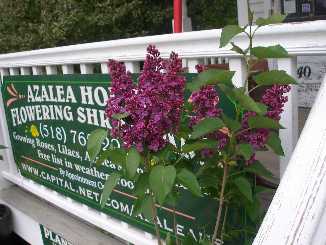 'Belle de
Nancy' 1891 (Class V pink double)
'Belle de
Nancy' 1891 (Class V pink double)Lilac hybridizer list, Lilacs, date introduced, short biography of hybridist, what location did he work in. Class and color of each lilac, Links at bottom to Lilac article on cultivation. Click the blue link for plants we grow at Azalea House Flowering Shrub Farm in Albany County, NY linked to a page that has more information and pictures of that variety as they mature and become available for retail. Links at bottom. Last updated Friday, September 26, 2014
Wister Color Code: Class I white, Class II Violet, Class III Blue, Class IV Lilac, Class V Pink, Class VI Magenta, Class VII Purple (Lilacs are often difficult to classify due to the difference in color blindness of its classifiers).
Click on the name of the plant you are interested in below.
Victor and son Lemoine introductions 1876 to 1953. Remember that a french Lilac is a double flowered Syringa vulgaris or hybrid. The Lemoine Nurseries in Paris introduced the first of these and modern french lilacs are descended from them.
 'Belle de
Nancy' 1891 (Class V pink double)
'Belle de
Nancy' 1891 (Class V pink double)
'Charles Joly' 1896 (Class VII Red Purple double)
'Congo' 1896 red flowers turn purple (Class VI magenta single)
 'Mme Lemoine' 1890
(Class I white double)
'Mme Lemoine' 1890
(Class I white double)
'Monge' 1913 (Class VII red-purple single)
'Paul Thirion' 1913 (Class VI magenta double)
'President Grevy' 1886 (Class III blue double) large panicles
'President Poincaire' 1913 (Class VI magenta double)
Wister Color Code: Class I white, Class II Violet, Class III Blue, Class IV Lilac, Class V Pink, Class VI Magenta, Class VII Purple.
Spaeth
 'Andenken an Ludwig
Spaeth' 1883 (Class VII purple single) often reduced to 'Ludwig
Spaeth' in catalogs
'Andenken an Ludwig
Spaeth' 1883 (Class VII purple single) often reduced to 'Ludwig
Spaeth' in catalogs
John Dunbar 1859-1927
(Assistant Superintendent of Parks in Rochester, NY 1891/ originator of Lilac Festival in May/
'President Lincoln' (Class III blue single)
'Adelaide Dunbar' (Class VII purple double) named after his wife
'General Sherman' (Class V pale pink single) turns white
Wister Color Code: Class I white, Class II Violet, Class III Blue, Class IV Lilac, Class V Pink, Class VI Magenta, Class VII Purple.
Hulda Thiel Klager 1864-1960
'My Favorite' magenta purple double
Theodore A. Havemeyer 1868-1936
'Sarah Sands' (Class VII purple single late bloomer) named after his sister in law, red purple
'Zulu' 1954 (Class II Violet single) dark violet
Miss Isabella Preston 1881-1965
(Joined Central Experimental Farm, Horticultural Department at Ottawa, Canada in 1920/crossed S. villosa and S. reflexa to get S. prestoniae/
Wister Color Code: Class I white, Class II Violet, Class III Blue, Class IV Lilac, Class V Pink, Class VI Magenta, Class VII Purple.
Dr. Frank Skinner, L.L.D., M.B.E 1882-1967
(Born in Scotland, in 1895 his parents moved to and settled in Dropmore in Northwestern Manitoba, Canada and produced a quantity of plants hardy in his region/)
(S.vulgaris x S.oblata dilatata hybrids)
'Assessippi' lavender lilac single
'Minnehaha' purple single
(S.villosa x S.reflexa hybrids)
'Donald Wyman' rosy purple single
'Hiawatha' magenta single
Wister Color Code: Class I white, Class II Violet, Class III Blue, Class IV Lilac, Class V Pink, Class VI Magenta, Class VII Purple.
Walter Clarke 1876-1953
(Clarke Nursery of San Jose, California/
'Esther Staley' 1948 lilac pink single
Dirk Maarse 1881-1975
born into the Maarse horticultural family in the Netherlands he specialized in hybridizing lilacs for the forcing industry (where they force cut flowers for the commercial flower trade)/forcing lilacs with heat often causes sports/
'Nanook' 1953 (Class I white single)
'Primrose' 1949 (Class I pale yellow single) there are actually two of these 'Primrose L' (A. Lumley) and 'Primrose H' (Holden Arboretum). They both seem to be white when viewed alone. When massed with other white flowering lilacs the yellow tinge is more obvious.
Yaeger
'James Macfarlane' 1959 (Class V pink single)
Cumming
'Miss Canada' 1967 (Class V pink single)
More later (I plan to describe each and continue with lilacs still in the trade).
We grow Lilacs until they flower (and publish a picture in the web site), then divide them while they are dormant inserting them into one gallon pots. This gives our customers a much heavier plant that is still easily shipped by flat rate priority mail (and you can see a picture of what the flower looked like on the plant we divided).
Shelterbelts, Hedges, Lilac Walks and Privacy barriers,